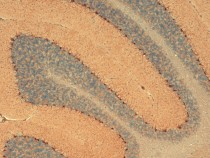ARG22222
anti-HCN1 antibody [S70-28]
anti-HCN1 antibody [S70-28] for IHC-Formalin-fixed paraffin-embedded sections,Immunoprecipitation,Western blot and Human,Mouse,Rat
Overview
| Product Description | Mouse Monoclonal antibody [S70-28] recognizes HCN1 |
|---|---|
| Tested Reactivity | Hu, Ms, Rat |
| Tested Application | IHC-P, IP, WB |
| Specificity | Detects ~100kDa. No cross-reactivity against HCN2. |
| Host | Mouse |
| Clonality | Monoclonal |
| Clone | S70-28 |
| Isotype | IgG1 |
| Target Name | HCN1 |
| Antigen Species | Rat |
| Immunogen | Fusion protein around aa. 778-910 (C terminus) of Rat HCN1 |
| Conjugation | Un-conjugated |
| Alternate Names | EIEE24; Brain cyclic nucleotide-gated channel 1; HAC-2; Potassium/sodium hyperpolarization-activated cyclic nucleotide-gated channel 1; BCNG-1; BCNG1 |
Application Instructions
| Application Suggestion |
|
||||||||
|---|---|---|---|---|---|---|---|---|---|
| Application Note | * The dilutions indicate recommended starting dilutions and the optimal dilutions or concentrations should be determined by the scientist. |
Properties
| Form | Liquid |
|---|---|
| Purification | Purification with Protein G. |
| Buffer | PBS (pH 7.4), 0.09% Sodium azide and 50% Glycerol |
| Preservative | 0.09% Sodium azide |
| Stabilizer | 50% Glycerol |
| Concentration | 1 mg/ml |
| Storage Instruction | For continuous use, store undiluted antibody at 2-8°C for up to a week. For long-term storage, aliquot and store at -20°C. Storage in frost free freezers is not recommended. Avoid repeated freeze/thaw cycles. Suggest spin the vial prior to opening. The antibody solution should be gently mixed before use. |
| Note | For laboratory research only, not for drug, diagnostic or other use. |
Bioinformation
| Database Links | |
|---|---|
| Gene Symbol | Hcn1 |
| Gene Full Name | hyperpolarization-activated cyclic nucleotide-gated potassium channel 1 |
| Background | The membrane protein encoded by this gene is a hyperpolarization-activated cation channel that contributes to the native pacemaker currents in heart and neurons. The encoded protein can homodimerize or heterodimerize with other pore-forming subunits to form a potassium channel. This channel may act as a receptor for sour tastes. [provided by RefSeq, Oct 2011] |
| Function | Hyperpolarization-activated ion channel exhibiting weak selectivity for potassium over sodium ions. Contributes to the native pacemaker currents in heart (If) and in neurons (Ih). May mediate responses to sour stimuli. [UniProt] |
| Cellular Localization | Membrane |
| Calculated MW | 99 kDa |
Images (4) Click the Picture to Zoom In
-
ARG22222 anti-HCN1 antibody [S70-28] IHC-Fr image
Immunohistochemistry: 10% Formalin (12-24 hours at RT) fixed Mouse frozen brain section stained with ARG22222 anti-HCN1 Antibody [S70-28] (brown) at 1:1000 dilution (1 hour). Counterstain: Mayer Hematoxylin (purple/blue) nuclear stain at 250-500uL for 5 minutes at RT.
-
ARG22222 anti-HCN1 antibody [S70-28] WB image
Western blot: Rat brain membrane lysate stained with ARG22222 anti-HCN1 Antibody [S70-28] at 1:1000 dilution.
-
ARG22222 anti-HCN1 antibody [S70-28] IHC-Fr image
Immunohistochemistry: 10% Formalin (12-24 hours at RT) fixed Mouse frozen brain section stained with ARG22222 anti-HCN1 Antibody [S70-28] (brown) at 1:1000 dilution (1 hour). Counterstain: Mayer Hematoxylin (purple/blue) nuclear stain at 250-500uL for 5 minutes at RT.
-
ARG22222 anti-HCN1 antibody [S70-28] IHC image
Immunohistochemistry: 10% Formalin (12-24 hours at RT) fixed Mouse Cerebellum stained with ARG22222 anti-HCN1 Antibody [S70-28] (brown) at 1:1000 dilution (1 hour). Counterstain: Mayer Hematoxylin (purple/blue) nuclear stain at 250-500uL for 5 minutes at RT.









